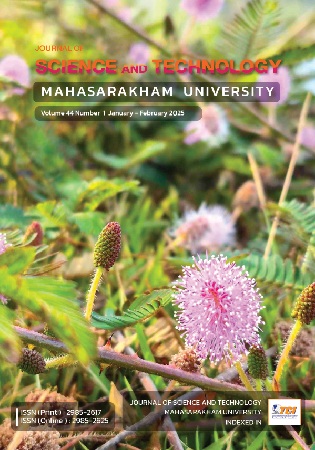ผลของทังสเตนสมมูลต่อความแข็งหลังผ่านกรรมวิธีทางความร้อนของเหล็กหล่อขาวเติมธาตุผสมกึ่งหลายชนิดที่มีค่าคาร์บอนสมมูลเท่ากับศูนย์
Main Article Content
บทคัดย่อ
งานวิจัยนี้ได้ศึกษาผลของค่าทังสเตนสมมูล (Weq) ต่อความแข็งหลังผ่านกรรมวิธีทางความร้อน ของเหล็กหล่อขาวเติมธาตุผสมกึ่งหลายชนิดที่มีค่าคาร์บอนสมมูล (Cbal) เท่ากับศูนย์ ได้ตรียมชิ้นงานที่มีค่า Weq เท่ากับ 6.0 ถึง 8.0% อบอ่อนชิ้นงานที่อุณหภูมิ 950°C เย็นตัวในเตา จากนั้นอบชิ้นงานที่ผ่านการอบอ่อนที่อุณหภูมิ 1050 และ 1100°C และชุบแข็งโดยใช้พัดลมเป่า (As-hardened state) อบคืนตัวชิ้นงานที่ผ่านการชุบแข็ง (Tempered state) ที่อุณหภูมิ 400-600°C ผลการทดลองพบว่าโครงสร้างจุลภาคโดยรวมของทุกชิ้นงานประกอบด้วยออสเทไนต์เดนไดรต์และโครงสร้างยูเทคติคชนิด (g+MC) และ(g+M2C) โดยปริมาณโครงสร้างยูเทคติค (g+M2C) มีแนวโน้มเพิ่มขึ้นตามค่า Weq ความแข็งในสภาพชุบแข็งลดลงเมื่อค่า Weq เพิ่มขึ้น ความแข็งในสภาพอบคืนตัว แสดงการแข็งขึ้นทุติยภูมิจากการตกตะกอนของคาร์ไบด์ทุติยภูมิและการเปลี่ยนเฟสจากออสเทไนต์เหลือค้างเป็นมาร์เทนไซต์ โดยระดับการแข็งขึ้นทุติยภูมิ (DHs) เพิ่มขึ้นตามปริมาณค่า Weq และอุณหภูมิชุบแข็ง ค่าความแข็งสูงสุดหลังการอบคืนตัว (HTmax) เกิดขึ้นที่อุณหภูมิอบคืนตัว 500°C ในทุกชิ้นงาน ค่าสูงสุดของ HTmax คือ 879 HV30 และ 848 HV0.1 ได้รับในชิ้นงาน 6.7%Weq ที่ผ่านการชุบแข็งที่ 1100°C และอบคืนตัวที่ 500°C
Article Details
References
Boccalini, M. (2011). high speed steels for hot rolling mill rolls. Abrasion Wear Resistant Alloyed White Cast Iron for Rolling and Pulverizing Mills, 123-142.
Chang, W., Pan, Y., Sasaguri, N., & Matsubara, Y., (2008). Effect of C and W content andheat treatment condition on microstructureand wear resistance of multi-componentwhite cast iron. Abrasion Wear Resistant Alloyed White Cast Iron for Rolling and Pulverizing Mills, 35-48.
Hashimoto, M., Kubo, O., & Matsubara, Y. (2004). Analysis of Carbides in Multi-component White Cast Iron for Hot Rolling Mill Rolls. ISIJ International, 44(2), 372-380
Hashimoto, M., Kubo, O., & Matsubara, Y. (2008). Development of multi-component cast iron (HSS) roll and rolling technology in steel rolling. Abrasion Wear Resistant Alloyed White Cast Iron for Rolling and Pulverizing Mills, 1-23.
Hashimoto, M., Kubo, O., & Matsubara, Y. (2011). Effects of Alloying Element on Compressive and Wear Properties of Multi-Component White Cast irons for Steel Rolling Mill Rolls. Abrasion Wear Resistant Alloyed White Cast Iron for Rolling and Pulverizing Mills, 183-192.
Inthidech, S., & Matsubara, Y. (2020). Effects of Carbon Balance and Heat Treatment on Hardness and Volume Fraction of Retained Austenite of Semi-multi-alloyed White Cast Iron. International Journal of Metalcasting, 14(1), 132-143.
Inthidech, S., Yamamoto, K., & Matsubara, Y. (2020). Effect of Tungsten Equivalent on Heat Treatment Behavior of Semi-multi-alloyed White Cast Iron for Abrasive Wear Resistance. International Journal of Metalcasting, 14(1), 1-12.
Khanitnantharak, W., Hashimoto, M., Shimizu, K., Yamamoto, K., Sasaguri, N., & Matsubara, Y. (2009). Effects of Carbon and Heat Treatment on the Hardness and Austenite Content of a Multi-Component White Cast Iron. Transactions of the American Foundrymen's Society, 117, 435-444.
Laird, G., Gundlach, R., & Rohrig, K. (2000). Abrasion-resistant cast iron handbook. American Foundry Society Illinois, 202-203.
Matsubara, Y., & Sasaguri, N. (2002). Heat treatment characteristic of multi-component white cast iron for cold work roll. Abrasion Wear Resistant Alloyed White Cast Iron for Rolling and Pulverizing Mills, 207-216.
Matsubara, Y., Sasaguri, N., Shimizu, K., Sung & Kon Yu. (2001). Solidification and abrasion wear of white cast irons alloyed with 20% carbide forming elements. Wear, 250(1–12), 502–510.
Matsubara, Y., Sasaguri, N., Wu, H.Q., Honda, Y., & Hashimoto, M. (1993). A new material for rolling mill rolls multicomponent white cast iron. Proceedings of the International Symposium on Tribology, 1993 Oct 19-22, Bejing China, 501-510.
Meebupha, T., Inthidech, S., Sricharoenchai, P. & Matsubara Y., (2017). Effect of molybdenum content on heat treatment behavior of multi-alloyed white cast iron. Materials transactions, 58(4), 655-662.
Mitsuo, H., Yasuyuki, N., Nobuya, S., & Yasuhiro, M. (2006). Influence of Carbon andVanadium on Mechanical and Hot Wear Properties of Multi-component White Cast Irons for Steel Rolling Mill Rolls. Journal of Japan Foundry Engineering Society, 78(5), 238–244.
Opapaiboon, J., Sricharoenchai, P., Inthidech, S., & Matsubara, Y., (2015). Effect of carbon content on heat treatment behavior of multi-alloyed white cast iron for abrasive wear resistance. Materials transactions, 56(5), 720-725.
Sasaguri, N., Matsubara, Y., & Hashimoto, M. (1996). Solidification process of multi-component white iron for rolls. Asian Foundry congress (AFC-4), 273-281.
Sinphakdee, P., & Inthidech, S. (2018).Effect of Carbon Balance on Hardness and Retained Austenite of Heat-treated Multi-alloyed White Cast Iron, Proceedings of the The 14th Mahasarakham University Research Conference (MRC#314), Mahasarakham, Thailand 52-60.
Wu, H-Q., Sasaguri, N., & Hashimoto, M. (1994). Solidification Structures and Their Quantitative Analysis of Multi-Component Cast Iron. Asian Foundry Congress (AFC-2), 109-119.
Wu, H-Q., Sasaguri, N., Matsubara, Y., & Hashimoto, M. (1995) Type and morphology of carbides precipitated in multi-component white cast iron. Imono, 67(1), 49-55.
Wu, H-Q., Sasaguri, N., Matsubara, Y., & Hashimoto, M. (1996) Solidification of multi-alloyed white cast iron: type and morphology of carbides. Transactions of the American Foundrymen's Society, 104, 103-108.
Yothathorn, N., & & Inthidech, S. (2018). Effect of Tungsten Equivalent on Hardness of Heat-treated Multi-alloyed White Cast Iron, Proceedings of The 14th Mahasarakham University Research Conference (MRC#314), Mahasarakham, Thailand. 227-235.
Yu, S.-K. (1997). Effects of Carbon Content on Microstructure and Amount of Austenite in As-Cast and Heat-Treated Multi-Component White Cast Iron. Journal of Korea Foundry Society, 17(5), 488-493.
Yuzo, Y., et al., (2010). Influence of molybdenum and tungsten contents on behavior of continuous cooling transformation in multi-component white cast iron. Journal of Japan Foundry Engineering Society, 82(1), 8-15.

